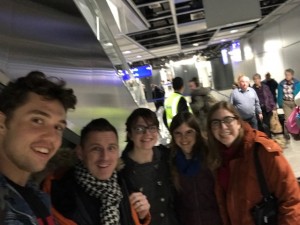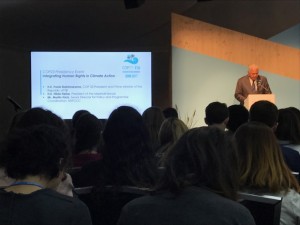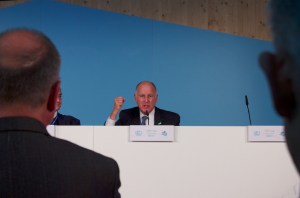 The first COP-24 delegation from Swarthmore has arrived in Poland! We are heading to the conference site this morning to get our badges so we are ready to hit the ground running tomorrow when the conference starts. Stay tuned for updates to hear what we are finding interesting during the week!
The first COP-24 delegation from Swarthmore has arrived in Poland! We are heading to the conference site this morning to get our badges so we are ready to hit the ground running tomorrow when the conference starts. Stay tuned for updates to hear what we are finding interesting during the week!
Author: Christopher Graves
COP23 Day 4 – Climate Justice Day
After an amazing day yesterday hearing some great speeches and listening to the high-level segment, I decided to stop listening to the dignitaries deliver their addresses and go to more events. We tried to attend the negotiations, but we couldn’t get in since they went closed door. From looking at the published schedule it does seem like the APA negotiations proceeded because the APA plenary is back on the schedule. A lot of talk this week has centered around the divide between the global North and South, which is primarily responsible for shutting down the APA plenary yesterday. We’ll see if this divide sneaks into the closing plenary of COP tomorrow.
Since we couldn’t get in the room to hear the wheeling and dealing, I attended some side events. The one that stood out most prominently for me was a Presidency Event Integrating Human Rights in Climate Action, a fitting topic given that today was Climate Justice Day! It was presided over by the United Nations Deputy High Commissioner for Human Rights (Kate Gilmore) and was opened by the COP23 President and Prime Minister of Fiji. He gave an excellent speech where the overarching message was that human rights are universal and our climate policies must protect the weak from the strong and give hope to those who are most vulnerable. The president of the Marshal Islands also gave opening remarks where she called for an end of the blame game, mentioning that all nations must be part of the solution and all actors have the responsibility to do what they can to help those in the most vulnerable places.
The panel discussion was excellent! The big take-a-ways were the need to engage everyone in climate action and to acknowledge the special circumstances, challenges, and opportunities that different groups bring to the table. One quote from a panelist: “If you aren’t at the table you are likely on the menu. Everyone needs to have a seat at the table.” Throughout this conference a lot of discussion has focused around gender inclusion as well as in engaging the indigenous peoples. Both groups had major wins at this COP, with the establishment of a Gender Action Plan and a Local Communities & Indigenous Peoples Platform. For decades the indigenous peoples have been trying to be engaged in the development of climate action, and there is a lot of positive energy here around the fact they’ve finally gotten an official voice. Hindau Oumarau Ibrahim, who has been a major presence at this COP, was a panelist during this session and once again gave a passionate speech about engaging the indigenous peoples to help develop ideas and install paths that will met their priorities. I have really enjoyed hearing her speak throughout the week. The session ended with a closing remarks from Mary Robinson, the president of the Mary Robinson Foundation – Climate Justice, where she urged us to feel good about the progress we’ve made and to use that energy to develop effective climate action strategies. All in all, it was an excellent session!

Week 2, Day 1 – Engage, Engage, Engage!
Today was our first day of the COP-23 meeting. I started the day by attending the RINGO debriefing meeting where we got the status on several of the negotiations pertaining to implementation of the Paris Agreement. It was a good way to start and gave a big picture overview of the progress made thus far. A general takeaway was that things are moving slowly, but the chair of the session assured us that this was normal.
For the rest of the day I moved to the Bonn zone and attended several side events. The theme of the talks/sessions from my day focused on the need and importance of engaging local communities and governments in the process of climate adaption and mitigation. I first attended the High-Level Opening of Global Climate Action where I saw Gov. Jerry Brown (CA) talk for the first (not the last) time. He spoke very passionately about the need for states to pick-up the slack where the federal US government has failed. He was followed by a panel of an interesting group of dignitaries from around the globe and from different sectors. The representative from the Indigenous People’s really stood out for me as she stressed the need to engage local people in the mitigation and adaption process and to enable them with an action plan. In this vein I also I went to a side event focused on regional collaboration centers (RCCs) that pair local government organizations with bigger entities to help establish carbon pricing (and other) initiatives. The panel was interesting as several people discussed their specific projects or hopeful projects, although the “high end” portion consisted of dignitaries patting themselves on the back, which I found dull.
I spent a good chunk of the middle of my day exploring the venue and the pavilion. What a great group of diverse individuals! I spent some time at a science hour at the German pavilion and gathered a lot of pamphlets and information that I think will help me in my courses next semester. I also discovered that the Russian pavilion is going to have an entire session Wednesday devoted to progress toward a more carbon neutral refining of aluminum (my favorite element) so I am pumped!
I wrapped the day up by attending a session on Sub-National Strategies in North American for Meeting the Paris Commitments. It was opened with two governors (Kate Brown (OR) and Jay Insee (WA)) discussing their state initiatives and commitments to battle climate change. It was the first time for me at this meeting where a person directly spoke about Trump. The opening was by an excellent panel with Canadian and Mexican dignitaries as well as Gov. Brown. I was really inspired about all the state and provincial level work being done in the three countries. I was also filled with hope when the Minister of the Environment from Ontario reminded the USA people that Canada once had an environmentally unfriendly federal government (the Harper administration) and in those time the provinces made huge initiatives. It was a ray of hope that the state-lead coalitions will be able to do great things under the Trump administration. I look forward to learning more about these initiatives during the We Are Still In events over the next few days.
